 Featural Lojban Abjad
Featural Lojban AbjadLojban is a philosophical planned language which aims to be logical to a degree that it is syntactically unambiguous enough to be parsed by a computer. Moreover, it has been designed keeping in mind cultural neutrality, with no bias towards the grammar, vocabulary and semantics of any human language or culture in particular, although it takes some influence from the most spoken languages.
Nevertheless, Lojban is often written using an orthography based on Latin lowercase letters. Although this is a practical choice for an orthography, it is certainly not culturally neutral. For this reason, some Lojban enthusiasts have coined various unofficial orthographies by developing novel scripts from the scratch, like 'zbalermorna' which is used on the online Lojban dictionary 'la sutysisku'.
The Featural Lojban Abjad (FLA), for the lack of a more creative name, is Punya Pranava Pasumarty's attempt at coining a new orthography for Lojban that (hopefully) lives up to the incredible design of this language. As the name suggests, this script is an abjad (fully vocalised), so the letters used herein are for consonants. A vowel sound that immediately follows a consonant, when present, can be placedas a diacritical mark below the consonant letter. The following are the letters (with IPA labels):
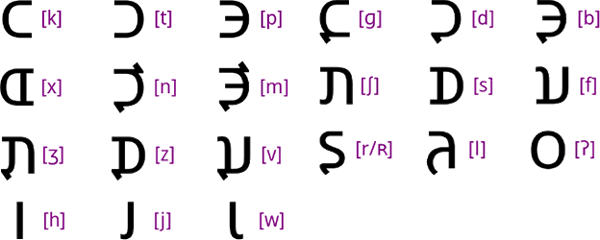
In the spirit of cultural neutrality, the shapes of the FLA letters are not based on any official writing system used for natural languages although there might be some coincidental semblances. Instead, they are featural, based on the place and manner of articulation of the sound in question. The letter shapes have been developed by simplification of diagrams representing the articulation of their sounds as portrayed on the sagittal section of the human head facing rightward, the direction of writing. The following is the template of the diagrams in question, with the relevant parts labeled:
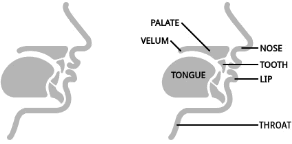
The following table shows the FLA letters arranged based on phonetic features and aligned with the respective diagrams that indicate their shapes:
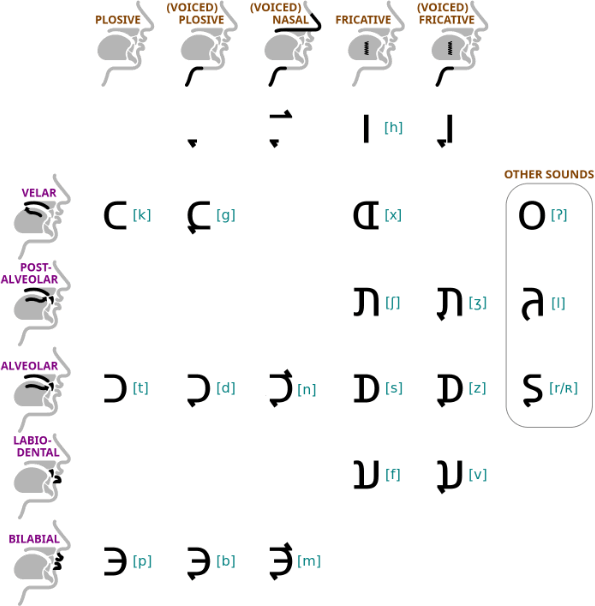
The following table shows the FLA letters arranged based on phonetic features and aligned with the respective diagrams that indicate their shapes: Here, the unvoiced plosive form (or if not present the unvoiced fricative form) for each place of articulation is taken as the base grapheme from which other letters for the same place of articulationare derived. Voiced versions of the aforementioned letters are indicated by adding a descender to the bottom-left of the base grapheme, which indicates the throat region, the source of 'voice'.
Nasal sounds (which, unless mentioned otherwise, are voiced) have an ascender to the top-right of the base grapheme in addition to the voicing feature mentioned above. The ascender represents the nose, for when nasal sounds are articulated, air flows through the nasal passage. Fricative sounds feature avertical bar along the middle of the base grapheme. The bar is symbolic of partial obstruction of airflow in a turbulent manner, as is typical of fricative sounds. The vertical bar on its own is also a letter, which represents the breathy vowel gap [h] sound of Lojban.
There are also 3 FLA letters (shown toward the right side of the table) whose shapes do not follow the same pattern as the other letters. These are the glottal stop, alveolar lateral approximant and rhotic.The glottal stop is shown as a simple loop that indicates the throat as viewed through the front of the mouth, similarly to the Hangul symbol for before an initial vowel in a syllable block. The alveolar lateral approximant is shaped to look similar to the other alveolar and post-alveolar letters and has a descender to the left indicating that it is voiced.
The rhotic letter looks the most different from other letters because the sound ascribed to it can be any rhotic according to Lojban phonology. This means that its place and manner of articulation are not completely defined. In FLA, the alveolar and uvular trill sounds are considered when designing the shape of the rhotic letter, for they are the more commonly used rhotic sounds among the natural languages of the world. The top half of the rhotic letter looks like the base grapheme for velar sounds (in this case it is suggestive of uvular sounds) and the bottom half looks like the base grapheme for alveolar sounds. In addition there is a descender to show that the rhotic is voiced. Together, these components form a zigzag shape that is suggestive of a trill sound.
Not only are the consonants of FLA featural, even the vowel marks are. These vowel marks are placed below the consonants they follow. This indicates that the vowels are 'vocalising' the consonant, thus positioned near the throat, the source of voice which, according to the diagram used for the letters, would be under the letter's baseline. This is not unlike how the descender of the letters for voiced consonants represents the voiced nature of that consonant. The following are the vowel marks (each shown below a greyed out glottal stop letter):
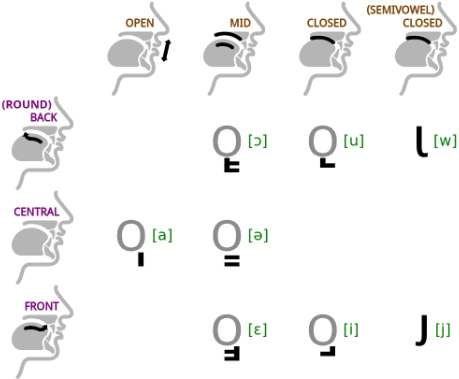
The open vowel is shown as a vertical dash to indicate its relative openness compared to other vowels. Closed vowels are shown with a horizontal dash to indicate their relative 'closedness'. Mid vowels have a double horizontal dash to show that they aren't as closed as the closed vowels (with some gap between the jaws).
The semivowel letters correspond to their respective closed vowel sounds but are used like letters rather than vowel marks. Thus, they look like rescaled forms of their respective vowel marks so that they function like letters in FLA while retaining their featural aspects. These are not phonetically related to the breathy vowel gap letter [h] despite the visual resemblance.
In FLA, any consonant letter can accommodate up to a single vowel mark below it. However, Lojban uses diphthongs as well. Since all diphthongs in Lojban either begin or end with a [j] or [w] sound, the semivowel letters can be combined with vowel marks to represent diphthongs. This works in the same way that consonant letters combine with vowel marks because the semivowel letters operate like consonants in FLA.
For those people familiar with the official orthography of Lojban, which uses lowercase Latin letters and some punctuation marks, the following image might help to correlate the official Lojban letters and marks with functionally equivalent symbols in FLA:
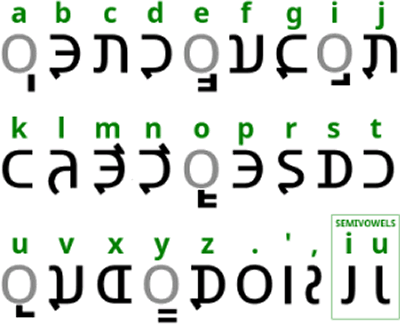
Note that the letter corresponding to the comma, as used in the official Lojban orthography, is a wavy reverse 'S' like symbol in FLA. This Lojban comma symbol is used to delimit 2 consecutive vowels gliding into each other rather than having a gap between them, unlike how the glottal stop or breathy gap letter [h] have, so the wavy form is intended to imply the gliding nature of this letter. This is used to transcribe certain proper names where diphthongs occur without involving semivowel sounds. Words used natively in Lojban do not employ this gliding letter (officially, the comma symbol).

ro remna cu se jinzi co zifre je simdu'i be le ry. nilselsi'a .elei ry. selcru .i ry. se menli gi'e se sezmarde .i .ei jeseki'ubo ry. simyzu'e ta'i le tunba
All human beings are born free and equal in dignity and rights. They are endowed with reason and conscience and should act towards one another in a spirit of brotherhood.
(Article 1 of the Universal Declaration of Human Rights)
Information about Lojban | Phrases | Numbers | Tower of Babel
Bhāratalipi Unified Indian Script (BLUIS), Charunagari, Deccan Lipi, Devadeshi, Ethiofarsi, Españabugida, Farsi Alefbet, Featural Lojban Abjad, Haruf-e-Tana, Palimukhi, Neobrahmi, SEAscript, West Eurolex
Constructed scripts for: Ainu | Arabic | Chinese languages | Dutch | English | Hawaiian | Hungarian | Japanese | Korean | Lingala | Malay & Indonesian | Persian | Tagalog / Filipino | Russian | Sanskrit | Spanish | Taino | Turkish | Vietnamese | Welsh | Other natural languages | Colour-based scripts | Tactile scripts | Phonetic/universal scripts | Constructed scripts for constructed languages | Adaptations of existing alphabets | Fictional alphabets | Magical alphabets | A-Z index | How to submit a constructed script
[top]
You can support this site by Buying Me A Coffee, and if you like what you see on this page, you can use the buttons below to share it with people you know.

If you like this site and find it useful, you can support it by making a donation via PayPal or Patreon, or by contributing in other ways. Omniglot is how I make my living.
Note: all links on this site to Amazon.com, Amazon.co.uk
and Amazon.fr
are affiliate links. This means I earn a commission if you click on any of them and buy something. So by clicking on these links you can help to support this site.
[top]